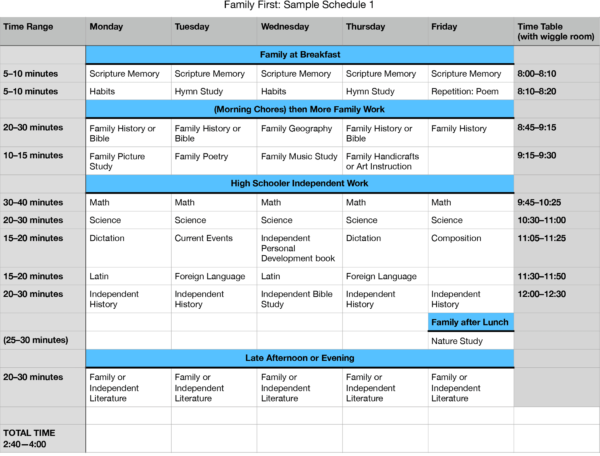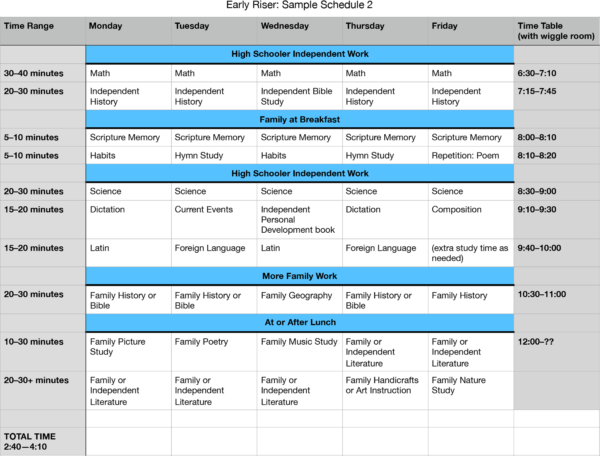60-day returns • free shipping on USA orders $129+
As homeschoolers, educating a child through the high school years is going to look different from a typical high school classroom situation. Most high schools are concerned with one thing: getting the course work done. But a Charlotte Mason-style home school looks at the whole person and has a broader goal.
We looked last time at developing the person through the curriculum—spreading a feast of ideas through a wide variety of subjects. Today, as we continue to answer your questions on high school, let’s talk a bit about how to develop the person through the schedule.
Yes, we want our high school students to get the work done, but that is only part of the big picture. We also want to help them solidify good habits, practice self-educating, and learn time management skills.
Those are important aspects to keep in mind as you determine your schedule.
High School Questions #9 and 10: What does a day look like—a schedule?
How would a daily and weekly schedule look?
There is no correct schedule for everybody. A schedule can be as varied as the personalities within your family. You have freedom to arrange your day and your week as will best fit your situation during this season of life. And you have permission to tweak that schedule, even completely rearrange it as needed.
Now, with that in mind, it can be helpful to look at a ready-made schedule as an example to glean ideas from. So here is a sample schedule that we will refer to as we discuss the rest of the scheduling questions. It is not THE high school schedule; it is one of many possibilities.
High School Question #11: How do you keep lessons short?
Lesson length gradually increases across the years as the student grows in the habit of full attention. By the time the student reaches the high school years, he should be able to work on a lesson for 45 minutes. Not all lessons will need to be that long, but that substantial time frame is not out of line for a student who has learned with Charlotte Mason methods and habits.
In the sample schedule above, only math is allotted that long of a lesson time. However, there is wiggle room allocated in the time table so the student could take more time for the other subjects as needed or finish an assignment after lunch.
High School Question #12: How do we keep lessons fairly short so they aren’t schooling from 8-4 and are still getting the feast and lunch break?
Charlotte Mason’s older students did classes for four hours in the morning, stopped for lunch, then had some afternoon studies too, like nature study or handicrafts. The sample schedule has most work done by 12:30 and then has a family read-aloud or independent literature reading time later in the afternoon or evening. It also puts nature study after lunch on Friday.
Here are a couple of tips to help keep lessons moving along and get work done in the time table.
First, be ever vigilant to keep an eye on the habit of attention. More time is wasted through distraction and dawdling than we realize. A lot can be accomplished in a short amount of time with full attention. Plus, it is a lifelong advantage. Your children will reap great benefits their entire lives if they can make themselves pay full attention.
Second, take a couple of minutes to gather all the books and materials you need for the day’s work before you begin. Put the stack in order and lay it where you will have easy access to it. If you will be working in two different areas of the house, put two stacks in place. A lot of time is wasted running back and forth to get needed materials and then trying to refocus attention.
Third, help your students pay full attention by setting up the sequence of subjects to use different parts of the brain in turn. So, for example, on Monday’s schedule, you will see a Family history read-and-narrate lesson followed by a picture study, then the high schooler does math. What you want to avoid is two read-and-narrate lessons back to back. By reading and narrating history, then looking at a work of art, then working with numbers, you have arranged the schedule to use different parts of the student’s brain, thus not over-fatiguing one part.
When one part of the brain gets tired, it has a harder time paying full attention. Varying the subjects in sequence will help your students give their best effort and move smoothly from one subject to the next without mental fatigue or the need for a break. Charlotte held that sometimes a change is as good as a break.
High School Question #13: Do you continue the family studies in high school? Meaning poetry, picture study, etc. And what does that look like with high schoolers and elementary kids mixed together?
You want to continue those subjects, yes. And doing them all together as a family will save you all time. As you see from the sample schedule, picture study, poetry, music study, etc. doesn’t require a lot of time but adds a nice variety to the day’s work.
If you factor in all the other family studies as outlined on the sample schedule, the morning Family work requires about an hour. That still leaves you plenty of time for your high school student’s individual work. And you can either regather for the family read-aloud later in the day or assign your student to read literature on his own during that time slot.
So you’re done with all the Family work in an hour and a half per day. That’s how the lesson plans are set up in our History Studies and Enrichment Studies lesson plan books, by the way. An hour and a half for family work, leaving about three hours for your high school student to complete individual work.
High School Question #14: How do we balance our days having an older child when there are still preschoolers, elementary, and middle schoolers in the mix?
You do want to take your high school student’s individual work times into account when you are setting up any Family work. It can be frustrating if he is constantly interrupted to come do ten minutes of picture study when he was just starting to write a narration on his science reading or to set aside his half-finished math lesson and come listen to the Family history reading.
What works well is to have set Family work chunks of time that your high schooler can count on and work his individual assignments around. You’ll see in the sample schedule that the Family work is mainly slotted for first thing in the morning, then the older student has the rest of the morning to focus on his own work until lunch time.
It would be helpful to sit down with your high school student and discuss what would work best for both of you. Perhaps he would rather do his individual work first and then meet for Family work around the lunch hour. Or perhaps he is an early riser and would like to do some of his individual work before breakfast. Here is an example of how you could tweak the sample schedule for that situation.
The main thing is to try to set a routine that respects your student’s preferences and works for your own needs with the younger ones, and then avoid interrupting him at odd times during his work hours.
High School Question #15: Should a high school student continue with Family Block readings? What if it takes too long with lots of littles and cuts into their work time?
It is a great benefit to the younger children to have your older one participate, modeling how to pay full attention and how to narrate. But you don’t want to fritter away your high schooler’s time and frustrate his efforts to accomplish his own assignments. So if family reading is causing more bickering than bonding, your teen could do those readings on his own. He can still join you all for the Enrichment Studies subjects—picture study, music study, nature study, poetry, and such—and would probably best enjoy those times if they were scheduled around lunch time, after he has had the whole morning to focus on his work.
High School Question #16: What does each subject look like at the high school level?
The Charlotte Mason methods stay the same. What changes is the difficulty level of the content and the amount of independent work you expect from the student. You are building on the groundwork that you have laid in the younger years. At this stage you and your student should be able to reap the dividends of the habits of full attention and best effort that have been instilled, and he should be able to carry most of the educational responsibility himself from learning how to self-educate through Charlotte’s methods.
The methods she used are brilliantly designed to transition into more and more self-education. As the student becomes a stronger reader and more fluent in narrations, he moves to reading and narrating on his own. As he learns how to observe closely and carefully and how to record his findings in a personal notebook, those skills transfer to his independent work. Probably most importantly, as he grows in an atmosphere that values knowledge for knowledge’s sake, he approaches his assignments with a desire to learn.
At this stage, then, your part moves to more of a supervisory role for your student’s individual studies: outlining the work that needs to be done, setting deadlines (and holding him to those deadlines!), going over his work, discussing ideas, answering questions, and tracking his progress.
High School Question #17: Should I give my high school student a weekly checklist or let him manage his own time? If he manages his own time, how do I make sure he is varying the order of subjects?
Some of that answer depends on the student. You should work toward helping him learn how to manage his time in the high school years, but some students may require more help in this area than others.
If your high schooler is naturally wired to organize his time, he will probably ask you for a weekly checklist so he can manage his assignments for himself. In that case, you could jump right into giving a weekly list and holding him accountable for those deadlines. What you might want to do is give him the list for the next week and ask him to come up with a plan and show it to you. That way you can give him feedback on the order of his subjects, explaining the benefits of using different parts of the brain in sequence, as well as identify any potential conflicts with family schedule or outside activities. Continue that initial check-in each week until you are confident that he has a good handle on creating his own schedule. Then simply move to holding him accountable to meet the deadlines you have specified.
If, however, your student is not naturally wired to be time conscious, you may need to ease into the process more gradually. First, you might just give him a day’s checklist and work with him to arrange it. At the end of the day, discuss his experience putting that schedule into practice. What worked? What needs tweaking? Where did he struggle? Once he can arrange the checklist into a good schedule, allow him to do that part on his own. Continue the daily checklists and discussions for a week or two, then try to give him two days of work at a time, then three, gradually working your way up to a week’s worth of assignments as he demonstrates progress. Your job becomes more of a counselor to help him accomplish his goals and to give the accountability that is so important for continued success.
The high school years are a time to start shifting personal responsibility onto your young adult’s shoulders. Making that shift little by little over all the years of high school will help ensure that he is prepared to take his place as a productive, responsible adult with the ability to self-educate, the advantages of good habits, and the skill of managing his time well.
CM mom with high schoolers, do you have a schedule that works well for you? Feel free to share it in the comments below.
Next time we will cover several questions on credits, grades, and transcripts in a Charlotte Mason high school education.
Podcast: Play in new window | Download




Loving this series. So far, what is working for us is to have my highschooler do her independent work first thing in the morning…after breakfast. I check with her mid-morning to see if it is a convenient time for her and then gather everyone for a family subject. Then she continues working independently, finishing sometime before lunch. After lunch we do our family literature read-aloud right before daily “quiet time”. During that time, she usually has a short reading to finish. It’s worked well this way so far.
I will say it again… I LOVE this blog series that you guys are doing. I think I say that each time but this one is sooo meaty and packed full of so much wisdom. Thank you!! ❤️❤️❤️
Learning from 8.00 until 12.30 in high school years? Is that really enough? I can’t imagine that. We seem to have fuller days and our oldest is only in 8th grade.
In rest, I like your tipps. I also think it is important to maintain the family work as much as possible. It’s not always easy, we have to be committed to that as mothers.
The next post in the series will go into more detail of how those hours of focused attention add up to the required credits in the U.S.
How would you handle needing an accredited diploma/transcript for high school but wanting to use SCM or CM ?
The next post in this series will go into detail on grades and transcripts with a CM approach, so check back soon for that.
What should I do if my student doesn’t finish a lesson in the time allotted? Should the work be continued the next day, finished later that same day, or should the assignment be continued right then until it is finished? I am also wondering where the written narrations fit into the sample schedule? I have a junior in high school doing 4 written narrations a week, each taking about 30 minutes to complete. Is this too much?
Four narrations a week for a junior sounds fine, Shelby. Usually the narration should fit into the time allotted for the subject—it would include the reading and narration. However, with those older high school students Charlotte gave some delayed narration time slots as well. So at that age the students might read a passage on Tuesday, then take 30 minutes on Thursday to write a narration on it. With that principle in mind, I don’t think it would be a problem for your student to finish the narration later. The main thing would be to see what works best for him. If it refreshes him to set it aside for a while and then come back, go for it. If, however, it frustrates him and makes him lose his train of thought, or if it diminishes the quality of his narrations, you might want to allow him to finish right then.
Another possibility would be to have him start the narration in writing, then if he is running out of time to finish in writing, you could allow him to finish orally.